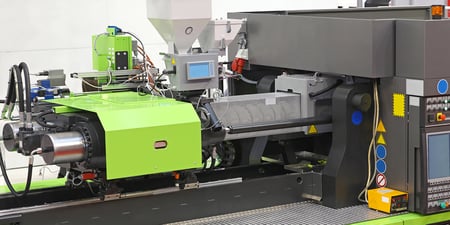For custom injection molders running multi-cavity tools, contamination is more than just a nuisance—it’s a threat to profitability. Black specks, streaks, and other signs of carbon contamination can cause cavity-specific defects, uneven quality, and high reject rates.
This is especially true when processing materials that contain pigments, additives, or flame retardants, which can degrade over time. Left unchecked, this buildup not only compromises part quality but also shortens tool life and increases maintenance costs.
Fortunately, carbon contamination isn’t inevitable. With the right preventive strategies—particularly around purging and shutdown procedures—custom molders can significantly reduce downtime and keep production moving.
Why High-Cavitation Molds Are So Vulnerable to Contamination
High-cavitation tools (16-, 32-, 64-cavity or more) introduce unique challenges:
- More flow paths mean more opportunity for uneven material flow and buildup
- Smaller gates and runners are harder to clean with standard purging methods
- Higher cycle counts increase thermal stress and degradation risk
- Longer hold times between cycles (or during interruptions) can cause hot spots and carbonization
Even a small amount of contamination inside one cavity can lead to blocked gates, shorts, or incomplete fills—issues that often aren’t caught until later in QA or customer inspection.
The Real Cost of Carbon Buildup
Carbon contamination isn’t just about quality loss. It’s also a hidden source of:
- Unplanned downtime from screw pulls or tool teardowns
- Lost labor from manual cleaning
- Material waste from off-spec parts
- Lost credibility when customers receive defective product
If left unaddressed, contamination in one cavity often spreads, increasing the likelihood of full-tool maintenance or emergency shutdowns. For custom molders balancing short runs, quick changeovers, and demanding schedules, this can quickly derail profitability.
Best Practices to Prevent Carbon in Multi-Cavity Injection Molding
- Use a High-Performance Purging Compound Regularly
Your best defense against carbon buildup is a purging compound designed for your processing temps and resin types. The right purge will:
- Dislodge degraded material and color residue
- Flow through small gates and runners
- Minimize manual cleaning between jobs
- Prevent layering between incompatible materials
Avoid purging with regrind or next-run resin—these may appear to clean the screw but often leave residue in the tool or hot runner system.
When production pauses—even for a few hours—resins can degrade inside the barrel or manifold, especially at high temperatures. This is where carbon begins to form.
Seal your machine with a thermally stable purge before shutting down. This prevents oxygen from reacting with the resin and eliminates the need for deep cleaning at startup.
- Establish Cavity-Level Inspection and Purging SOPs
In high-cavitation molding, not all cavities will show contamination at the same time. Regular cavity-by-cavity visual inspection (or automated vision systems) can help catch problems early.
Document standard purging procedures and inspection intervals, especially:
- After running filled or flame-retardant resins
- Between dark-to-light color changes
- At the end of each shift
Consistency across operators helps avoid overlooked contamination and builds a cleaner, more efficient process.
Bonus Tip: Schedule Preventive Maintenance Around High-Risk Resins
Materials with high processing temperatures or additive loads (e.g., glass-filled nylons, FR PP, or PEEK) are more prone to carbonization. Consider scheduling additional purging or cavity cleanouts after long runs with these materials—even if contamination hasn’t yet appeared.
This proactive approach reduces the frequency of full teardowns and improves long-term tool performance.
Final Thoughts
For custom molders, carbon buildup in multi-cavity tools is a preventable problem—but only if addressed systematically. Relying on regrind or reactive cleaning means you’re already behind.
With regular use of the right purge, a consistent shutdown process, and cavity-level inspection habits, your team can avoid black specks, reduce downtime, and extend the life of your most valuable tools.
In an industry where every hour of uptime matters, clean machines make better parts—and better margins.
Ready to see the difference Asaclean® can make in your production? Request a free sample today and experience how our purging compounds can enhance your color change efficiency, reduce waste, and improve your manufacturing process. Our team of experts is here to guide you through the process and help you achieve the best results. Contact us now to get started!

Tom Hanvey is the Associate Director of Marketing & Sustainability at Plastics North America. Before joining APNA, he worked as the Senior Marketing Manager for Asaclean Purging Compounds. He's worked in the plastics industry for over 10 years and focuses on recyclable resins and on the inbound marketing side, providing easy-to-digest content to processors looking for an edge on their competition.








Comments